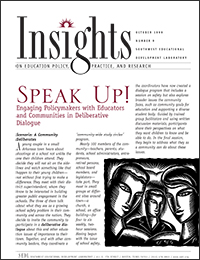What is Deliberative Dialogue?
SEDL Research on Deliberative
Dialogue and Public Policy
In 1993, Southwest Educational Development Laboratory (SEDL) produced an Insights policy brief, “Education Activism of Cultural Conservatives,” to help regional audiences better understand the source and nature of opposition from well-organized public groups to various education policies, curricula, and practices. In addition to describing the context for controversy in public education, the policy brief challenged both education agencies and policymakers to build and maintain productive, ongoing relationships with the public (Mutchler, 1993, pp. 17-18). Among strategies offered in the policy brief was the recommendation that readers find ways to “open the dialogue about education policy and practice to all constituents with all points of view, in new and different ways” (p. 15).
SEDL has since been exploring the concept of deliberative dialogue and its application for helping to resolve tensions between education reform efforts and public support for these efforts. “Speak Up! Engaging Policymakers with Educators and Communities In Deliberative Dialogue” discusses the general characteristics of deliberative dialogue and how it might benefit policymakers, educators, and the general public as they seek to improve public education.
Subsequent Insights policy briefs in this topic series will address how state policymaker participation in study circles affects the state education policy development process. The series will draw on findings from a research study in which SEDL has been involved. The study is part of the Calling the Roll: Study Circles for Better Schools program that took place from September through November of 1998 in 15 communities in Arkansas and Oklahoma. Working collaboratively, SEDL, the Study Circles Resource Center (SCRC), Arkansas Friends for Better Schools (with research assistance from the Center for Research on Teaching and Learning, University of Arkansas, Little Rock), and the League of Women Voters of Oklahoma (with research assistance from the Department of Sociology, University of Oklahoma, Norman), developed and implemented study circles on education in the two states.
The primary goals of research by SEDL in Calling the Roll have been to: 1) explore how state policymaker participation in study circles affects the education policymaking process, and 2) learn about the process of implementing a statewide program of study circles on education that include state policymakers.
Advocates of deliberative dialogue build on a long history of engaging the public. Since colonial town meetings in the 1600s, Americans have engaged in various forms of dialogue as a means for individuals to share opinions with each other in a democratic manner.
SEDL uses the term "deliberative dialogue" to refer to a face-to-face method of public interaction in which small groups of diverse individuals exchange and weigh ideas and opinions about a particular issue in which they share an interest. In some methods of deliberative dialogue, such as the study circle, participants begin the discussion from their personal experience with the issue and proceed over time to examine multiple views and perspectives. In the end, whether or not they come to consensus, the group will ideally understand the complexities of the issue and come to an informed opinion about it.
The concept of deliberative dialogue may be better understood by contrasting it with other methods of voicing ideas and opinions:
- Public opinion research. Daniel Yankelovich distinguishes deliberation—or what he refers to as coming to “public judgment”—from opinion research, which is usually conducted using polls or surveys with which to quickly assess the “will of the people.” He argues that public opinion polls measure only the “vagaries of public viewpoint at a moment in time, however vague, confused, ill informed, and clouded with emotion it may be” (National Issues Forums [NIF], N.D., p. 32).
Deliberative dialogue provides a forum in which to assess the “public’s viewpoint once people have had an opportunity to confront an issue seriously and over an extended period of time” (NIF, N.D., p. 32). - Public hearings and meetings. Local communities are familiar with the concept of public engagement (although perhaps not the best term) when it comes to school board, neighborhood association, and city council meetings that are open to the public. Unlike these community-centered meetings or public hearings, which often attract the same faces and voices from local professional, policy, and advocacy groups, deliberative dialogue ideally involves representatives of every major point of view in the community, including those who have been historically underrepresented in public forums. Rather than respond to presentations or proposals by experts and advocates, deliberative dialogue participants engage in a structured exchange of ideas on a social issue of common concern in a safe, neutral setting. Participants do not attend only to be heard or to listen, but to think together with others from their community and examine the multiple perspectives available.
- Debate. Deliberative dialogue differs from debate in that dialogue involves two or more sides working collaboratively toward common understanding, rather than two sides opposing each other and attempting to prove each other wrong. In debate, winning is the goal, and thus those involved listen to each other with the purpose of finding flaws and countering arguments. They seek to affirm their own points of view and assumptions and defend their position as the best solution. Deliberative dialogue participants, on the other hand, listen to other perspectives in order to understand, find meaning, and reach agreement. With finding common ground as the goal, they attempt to keep an open mind, and reevaluate, weigh, enlarge and possibly change their own points of view. This open-ended process sometimes produces better solutions than any originally considered (Study Circles Resource Center [SCRC], 1996).
Communities that have engaged in deliberative dialogue report anecdotal evidence suggesting that participants developed shared, better informed—although not necessarily consensus—opinions, clearer definitions of persistent problems, more coherent perceptions of the range of solutions and their consequences, and a sense of public priorities (Southwest Educational Development Laboratory [SEDL], 1998).
Next Page: What Are Some Deliberative Dialogue Models?

